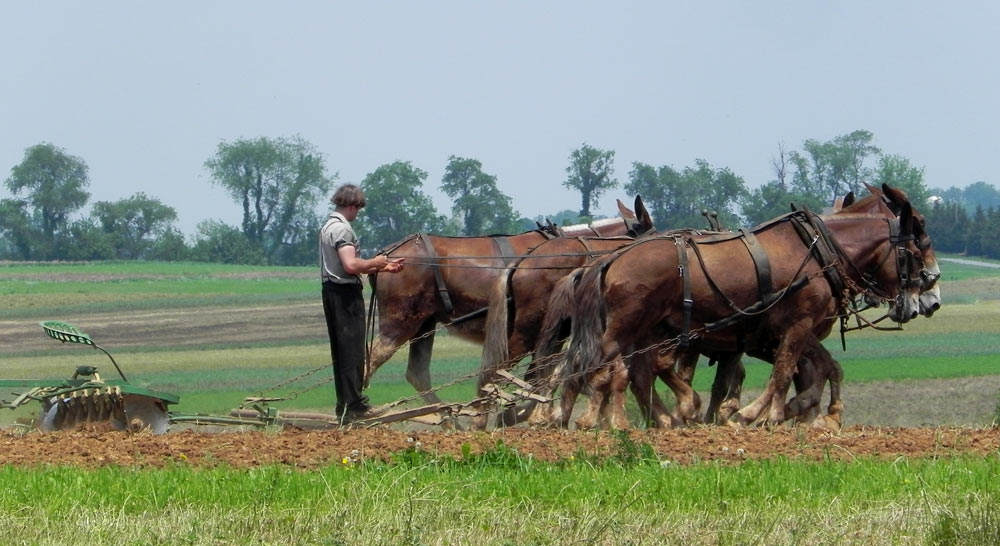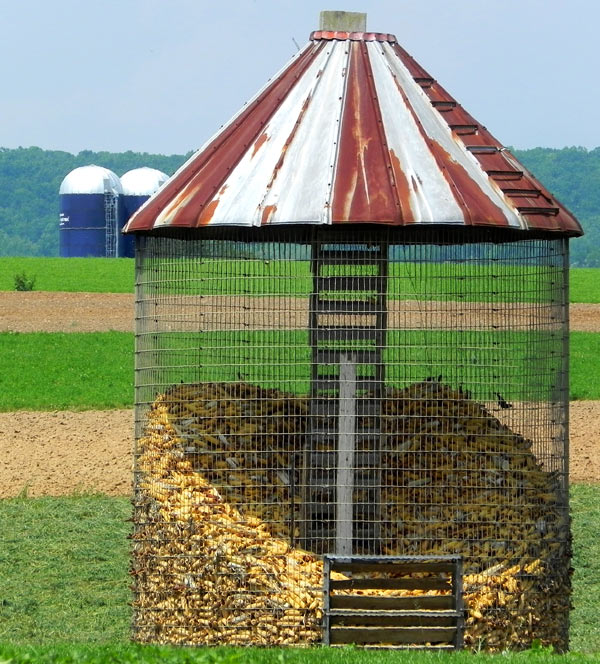Amish farming holds lessons for sustainable agriculture, USU sociologist says
June 6th, 2011 Posted in Arts and LifeStory & Photos by D. Whitney Smith
LOGAN—Pennsylvania could be an agricultural hub in America worth taking a look at when it comes to analyzing sustainable farming techniques such as the ones described in a recently published Science magazine article on “Transforming U.S. Agriculture,” coauthored by USU sociology professor Douglas Jackson-Smith.
Some connections can be made between what Jackson-Smith and his colleagues studied and what the Pennsylvania Amish do, he says, such as the once common practice of integrated crop and livestock operations.
 “Although the Amish case is rather unique,” Jackson-Smith said, “and not always a great example of sustainability that would be replicable on most U.S. farms.”
“Although the Amish case is rather unique,” Jackson-Smith said, “and not always a great example of sustainability that would be replicable on most U.S. farms.”
He said he would speculate that Amish farmers are probably discouraged from continuing in their traditional farming practices due to current governmental policies. He added that one of the purposes of the Science magazine article is to influence the upcoming renewal of the U.S. Farm Bill in a way that would encourage more sustainable farming methods.
Daniel Beiler, an Amish farmer from Lancaster County, Pa., said he heard talk of a possible mandatory inspection of all of the crops that he grows. He said each of his several crops would have to be inspected separately. He grows about eight different vegetables both for selling and feeding to his family.
“The thing that makes me mad is they say they want you to pay the inspector to inspect your crops,” Beiler said. “So if it costs me $200 to $300 to pay the inspector, then there goes my profit for those crops.”
As Beiller readied a team of horses for his horse-driven plow, he said he is discouraged from using his animals in the field because if one of them defecates in the field—hard to avoid in driving horses—federal regulations prevent him from selling crops growing within 25 feet of where the animal pooped.
It is a struggle to keep up with the ever-changing nature of government regulations as well as the market constraints that are placed on smaller farming operations like those of the Amish, Beiler said.
 This is one of the issues Jackson-Smith and his coauthors discuss in their Science magazine research: there are four main goals of sustainable farming, he said—the first one is the most obvious, to produce the necessary outputs such as food, fuel and fiber. The second goal is to sustain the quality of the natural environment.
This is one of the issues Jackson-Smith and his coauthors discuss in their Science magazine research: there are four main goals of sustainable farming, he said—the first one is the most obvious, to produce the necessary outputs such as food, fuel and fiber. The second goal is to sustain the quality of the natural environment.
“We pushed beyond environment, and we had two other goals,” Jackson-Smith said. “One is the economic viability of farming and farmers—that’s a big issue that’s separate from those first two; and the fourth one is enhancing social welfare.”
Certain elements of social welfare that Jackson-Smith and his fellow authors focused on in their article included the well-being of farm families, the quality of life in rural communities and focusing on the labor experience of those who are hired to work on farms.
Rufus Hoover, another Lancaster County, Penn., farmer, said he grew cantaloupes for more than 30 years as a way to feed his family and support their homestead. However, he said, he grew tobacco to pay the taxes on his farm.
“Tobacco was the cash crop, that’s what put Lancaster County on the map,” Hoover said.
The government has progressively made it harder for Amish and Mennonite farmers in Lancaster County to subsist in their traditional ways, he said.
“I wish the government would keep their noses out of it,” Hoover said.
This is one of the findings of Jackson-Smith’s study. Many farmers tend to be funneled into growing within a narrow range of crops, he said—such as soy, wheat, corn, rice and cotton. Government subsidies and market forces drive farmers to grow these crops, he said, which limits the profits and sustainability they can achieve by growing other crops.
Jackson-Smith said sustainable farming is a term that is used by many people in many different ways. The most common form of sustainable farming is organic farming, he said, and organic farming, as popular as it has become, is not always the most economically or socially sound.
“That’s probably the one system that’s received the most single attention in the last 20 years,” Jackson-Smith said. “But there are many good examples of systems that might not be strictly speaking organic that utilize a lot of the same tools and approaches and systems of thinking.”
The Rodale Institute in Emmaus, Penn., has been at the forefront of organic and sustainable farming research since 1947, said Rodale’s communications coordinator Cathy Facchiano. She said Rodale works closely with the institute to educate consumers on the benefits of organic and sustainable farming.
“Actually, a lot of the original research 20 years ago, when the universities were really not doing any of it, was pioneered at Rodale,” Jackson-Smith said.
He said it is important for the upcoming renewal of the U.S. Farm Bill, in 2012, that policy-makers are well informed about the benefits of sustainable farming as well as the detriments and disincentives that current policies pose for all types of farmers.
TP
Tags: Amish, Douglas Jackson-Smith, Lancaster County Pennsylvania, susatinable farming

Sorry, comments for this entry are closed at this time.